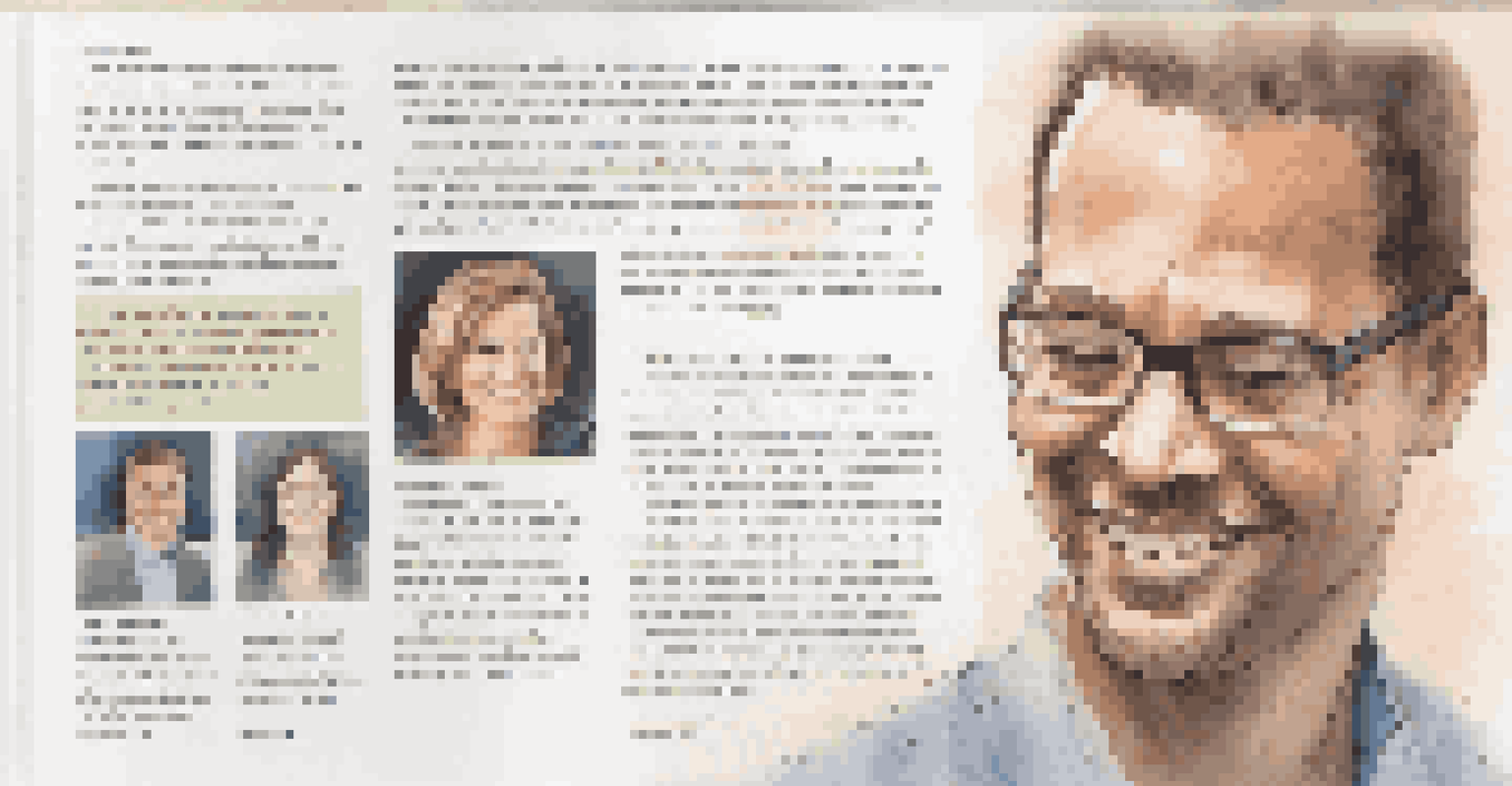Creating a Professional Portfolio: Showcase Your Skills

Understanding the Purpose of a Professional Portfolio
A professional portfolio is more than just a collection of your work; it's a powerful tool that showcases your skills and experiences. Think of it as your personal marketing brochure, designed to attract potential employers or clients. It allows you to present your best work in a structured way, giving others a glimpse of what you can do.
Your portfolio is your brand. It’s a reflection of who you are, what you do, and how you do it.
By understanding the purpose of your portfolio, you can tailor it to meet your career goals. Whether you're seeking a new job, promoting freelance services, or applying for a university program, your portfolio should reflect your unique brand. Remember, it’s not just about what you’ve done, but how you present that to your audience.
Ultimately, a well-crafted portfolio can set you apart in a competitive job market. It acts as a visual resume, allowing you to tell your story through your work. This is your chance to shine, so make sure you know the message you want to convey.
Deciding on the Format of Your Portfolio
When it comes to portfolios, there are various formats to consider, each with its own advantages. You could choose a digital portfolio, which is easily accessible and can include multimedia elements, or a physical portfolio that allows for tactile engagement. Think about your industry and audience when selecting the format that best showcases your work.

For example, graphic designers often benefit from a visually striking digital portfolio that includes interactive elements, while writers may opt for a simple, clean layout that prioritizes text. A mixed approach can also be effective; consider having both a digital version for online sharing and a physical one for face-to-face meetings.
Purpose of a Professional Portfolio
A professional portfolio showcases your skills and experiences, acting as a personal marketing tool to attract potential employers or clients.
Ultimately, the format should enhance the viewer's experience and make it easy for them to navigate through your work. Whichever option you choose, ensure that it aligns with your personal style and the message you want to communicate.
Choosing the Right Projects to Showcase
Selecting projects for your portfolio can feel overwhelming, but focusing on quality over quantity is key. Aim to highlight your best work that demonstrates a range of skills and experiences relevant to your target audience. This way, you can effectively showcase your expertise without overwhelming viewers with too much information.
The best way to predict the future is to create it.
Think about including projects that not only highlight your technical abilities but also showcase your problem-solving skills and creativity. For instance, if you’re a web developer, include a project where you overcame a significant challenge or implemented a unique feature. These stories resonate with potential employers and illustrate your value.
Remember to curate your portfolio regularly; as you grow and take on new projects, replace older work that no longer represents your current skills. This keeps your portfolio fresh and relevant, ensuring that it continues to impress over time.
Crafting an Engaging Narrative for Your Portfolio
Your portfolio isn’t just about the visual presentation; it’s also an opportunity to tell your story. Consider adding context to your projects by explaining your role, the challenges faced, and the results achieved. This narrative layer helps potential employers understand not just what you did, but how you think and approach problems.
For example, instead of just showcasing a completed design project, share the thought process behind it, including any iterations or feedback you received along the way. This gives viewers insight into your collaborative skills and adaptability, which are highly valued in most industries.
Choosing Projects Wisely
Highlight quality projects that demonstrate your range of skills and creativity to effectively showcase your expertise to your target audience.
Crafting a narrative can transform your portfolio from a simple collection of work into a compelling story about your professional journey. This personal touch can make a lasting impression and help you connect with your audience on a deeper level.
Designing for Visual Appeal and Usability
The design of your portfolio plays a crucial role in how your work is perceived. A clean, organized layout helps guide the viewer’s eye and makes it easy to navigate. Consider using consistent fonts, colors, and spacing to create a cohesive look that reflects your personal brand.
Visual appeal is essential, but usability should never be sacrificed. Ensure that your portfolio is easy to navigate, with clear headings and intuitive categories. A potential employer should be able to quickly find the information they need, without feeling lost or overwhelmed.
Additionally, incorporate high-quality images and videos wherever possible. These elements can significantly enhance the overall aesthetic and provide a clearer view of your work, making it more engaging for your audience.
Incorporating Testimonials and Recommendations
One effective way to boost your portfolio's credibility is by including testimonials from previous clients, colleagues, or supervisors. These endorsements can provide social proof of your skills and work ethic, making your portfolio more persuasive. Consider adding a dedicated section for testimonials to highlight key quotes or feedback.
When gathering testimonials, aim for specific feedback that speaks to your strengths. For example, a testimonial that mentions your ability to meet tight deadlines or your collaborative spirit can be more impactful than a generic compliment. This specificity gives potential employers a clearer picture of what to expect when working with you.
Regular Updates for Relevance
Consistently refresh your portfolio to reflect new skills and projects, ensuring it remains current and aligned with industry trends.
Don’t forget to request permission before including someone’s testimonial in your portfolio. A personal touch, like a handwritten note, can also make a positive impression. Overall, testimonials add a layer of authenticity to your portfolio, reinforcing your professional image.
Regularly Updating Your Portfolio for Relevance
Creating a professional portfolio is not a one-time task; it requires regular updates to remain relevant. As you complete new projects, gain new skills, or shift your career focus, take the time to refresh your portfolio. This ensures that it accurately reflects your current capabilities and experiences.
Consider setting a schedule for portfolio updates—whether quarterly or biannually—to review your work and make necessary changes. During this time, assess what projects to keep, what new work to include, and how to improve the overall design and narrative.

Additionally, staying updated with industry trends can inform how you shape your portfolio. By showcasing contemporary skills and knowledge, you can position yourself as an informed professional who is ready for new challenges.